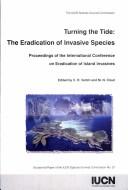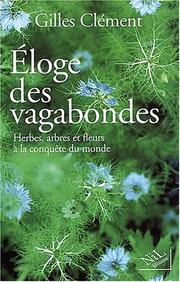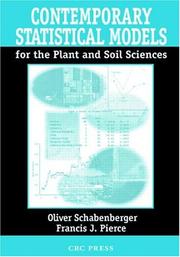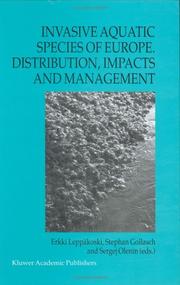| Listing 1 - 6 of 6 |
Sort by
|

ISBN: 2831706823 Year: 2002 Publisher: Gland : IUCN (International Union for Conservation of Nature and Natural Resources),
Abstract | Keywords | Export | Availability | Bookmark
 Loading...
Loading...Choose an application
- Reference Manager
- EndNote
- RefWorks (Direct export to RefWorks)
Wild plants --- Wild plants --- wild animals --- wild animals --- Dominant species --- Dominant species --- Animal introduction --- Animal introduction --- Plant introduction --- Plant introduction --- Islands --- Islands --- Lutte --- Lutte
Dissertation
Year: 2002
Abstract | Keywords | Export | Availability | Bookmark
 Loading...
Loading...Choose an application
- Reference Manager
- EndNote
- RefWorks (Direct export to RefWorks)
The present study was undertaken in the Department of Séguéla (Northwest of Côte d'Ivoire). The concerned population belongs to the Malinké ethnic group. The main objective was to identify some wild plants, which valorisation might contribute to the well-being of rural people living in the area. From ethnobotanical surveys, a list of 138 wild plants has been established. The gathered plants provide foodstuffs (98 species), medicinal products (47 species) and materials for domestic uses (22 species). An ethnotaxonomical study showed that the malinké system of naming and classifying wild plants is close to those of other peoples. The classification of wild fruit species is more structured and based on botanical considerations. The latest information indicates that fruit species are more important than the other plants. Concerning the identification of promising species, the data gathered from literature have indicated that the pharmacological activities of 11 medicinal plants jus tify their local uses in the studied region. The comparison with some similar works shows that the local uses of 57 % of medicinal plants are reported from other rural peoples living in tropical regions. Accordingly, it was considered that the malink popular medicine is more or less well-adapted to the existing diversity. Among edible products, wild fruit species were particularly investigated because of their numerical importance (98 species out of 138). The surveys show that the number of wild fruit known and usually consumed is limited in comparison with existing diversity. Some very appreciated fruit types are rich in vitamins A and C. But the consumption of fleshy ones is limited to the production season because they are not used as manufactured products (drinks, sweets, etc.) that might be conserved for a long time. The Malink are not interested in the domestication of wild plants, even those bearing locally appreciated fruit. Some wild seeds gathered during the surveys provide v egetable oils which constitute potential sources of nutriments (essential fatty acids), pharmacological products and raw materials for some industries (fuel, lubricant, soap, ink, varnish, etc.). Unfortunately, these resources remain hardly or not exploited in spite of their nutritional, medicinal and economical values. The local knowledge of these oleaginous species and their uses is decreasing from generation to generation. Therefore, they are threatened with destruction for agricultural purposes. In addition to ethnobotanical surveys, two species were particularly investigated : a wild leguminous, Uraria picta (Jacq.) DC. (Fabaceae) and a "water liana", Cissus populnea Guill & Perr. (Vitaceae). The profile of Uraria picta seeds (protein and lipid content) is very close to some cultivated legumes consumed in the region. The chemical score obtained after analysis, about 87 %, indicates a good balance of essential amino acids, which represent 38, 7 % of total amino acids. Accordingly, it was noticed that the seeds of Uraria picta should be considered as a potential source of essential amino acids for the diet of rural people. Concerning the "water liana" Cissus populnea, the investigation showed that the amount of collected sap depend on the extracting techniques and on the part of stem used. The analysis of the sap chemical composition reveals an satisfactory mineral profile, in line with the standards required by the European Union. Finally, the work provides a list of 31 promising wild plants that should be taken into account in projects of preservation and management of biodiversity in relation with sustainable development.
Wild plants --- Wild plants --- Crops --- Crops --- Drug plants --- Drug plants --- Nonwood forest products --- Nonwood forest products --- Plant introduction --- Plant introduction --- Biodiversity --- Biodiversity --- food security --- food security --- Ethnobotany --- Ethnobotany --- Indigenous knowledge --- Indigenous knowledge --- Urania picta --- Cissus populnea --- Cote d'Ivoire. --- Cote d'Ivoire --- Urania picta --- Cissus populnea
Dissertation
Year: 2002 Publisher: Gembloux : Paris-Grignon : FUSAGx ; INA,
Abstract | Keywords | Export | Availability | Bookmark
 Loading...
Loading...Choose an application
- Reference Manager
- EndNote
- RefWorks (Direct export to RefWorks)
Spice crops --- Spice crops --- Drug plants --- Drug plants --- Germination --- Germination --- Plant introduction --- Plant introduction --- cultural methods --- cultural methods --- Diversification --- Diversification --- Achillea millefolium --- Achillea millefolium --- Echinacea purpurea --- Echinacea purpurea --- Echium plantagineum --- Levistichum officinale --- Lunaria annua --- Thymus vulgaris --- Scotland --- Scotland --- Echium plantagineum --- Levistichum officinale --- Lunaria annua --- Thymus vulgaris

ISBN: 284111256X Year: 2002 Publisher: Paris : Editions NiL,
Abstract | Keywords | Export | Availability | Bookmark
 Loading...
Loading...Choose an application
- Reference Manager
- EndNote
- RefWorks (Direct export to RefWorks)
Plante de culture --- Crops --- Plante sauvage --- Wild plants --- Mauvaise herbe --- Weeds --- Phytoécologie --- plant ecology --- Biogéographie --- Biogeography --- Introduction de plantes --- Plant introduction --- Adaptation --- Succession écologique --- ecological succession --- world --- ETH Ethnobotany & Economic botany --- aliens --- ecology --- ethnobotany & economic botany --- history of agriculture --- phytogeography

ISBN: 1584881119 9781584881117 9780429120657 9781466544031 Year: 2002 Publisher: Boca Raton CRC
Abstract | Keywords | Export | Availability | Bookmark
 Loading...
Loading...Choose an application
- Reference Manager
- EndNote
- RefWorks (Direct export to RefWorks)
Plants, Cultivated --- Soil science --- Statistical methods. --- 519.24 --- -Soil science --- -Pedology (Soil science) --- Agriculture --- Earth sciences --- Cultivated plants --- Domestication --- Plant introduction --- Plants, Useful --- Special statistical applications and models --- Statistical methods --- -Special statistical applications and models --- 519.24 Special statistical applications and models --- -519.24 Special statistical applications and models --- Pedology (Soil science) --- Plants, Cultivated - Statistical methods. --- Soil science - Statistical methods.

ISBN: 1402008376 9048161118 9401599564 Year: 2002 Publisher: Dordrecht : Kluwer Academic Publishers,
Abstract | Keywords | Export | Availability | Bookmark
 Loading...
Loading...Choose an application
- Reference Manager
- EndNote
- RefWorks (Direct export to RefWorks)
The global scale of alien species invasions is becoming more and more evident in the beginning ofthe new millennium. Though the problem ofbiological invasions became a rapidly growing research area, there are large gaps still, both geographically and the matically, to be filled in the near future. This book is the first attempt to provide an overall picture of aquatic species invasions in Europe. Its geographical scope stretches from Irish waters in the west to Volga River and the Caspian Sea in the east, and from Mediterranean in the south up to the Arctic coast of Europe. Not all parts of the continent could be equally covered, as in some countries species invasions are not studied yet. The book tends to represent the array of all major European aquatic systems on the broadest geographical and ecological scope possible from fully saline seas, semi-enclosed brackish water bodies and coastallagoons to freshwater lakes, major river systems and waterways. The key objectives include the present status and impacts caused by non-native aquatic species in European waters. Please note that lengthy species lists submitted for publication and additional informa tion were put on the Internet, as the electronical version of these tables benefits from computer assisted search for data (http://www. ku. lt/nemo/EuroAquaInvaders. htm). Altogether more than 100 scientists from 24 countries have joined to synthesize the available information on bioinvasions. However, the book does not claim to be fully comprehensive.
Nonindigenous aquatic pests --- Pest introduction --- Animaux et plantes nuisibles aquatiques non indigènes --- Mauvaise herbe aquatique --- Aquatic weeds --- Cours d'eau --- Rivers --- canals --- Région marine --- Marine areas --- Biomasse --- biomass --- Écosystème --- ecosystems --- Impact sur l'environnement --- Environmental impact --- Europe --- 574.5 --- 574.91 --- 639.2.053.3 --- Hydrobiology. Aquatic biocoenoses and ecosystems. Food chains --- Migration. Change of habitat --- Biological factors affecting fishing. Fish migration. Tagging, marking --- Environmental Sciences and Forestry. Ecology --- Basic Sciences. Geography --- Aquatic Ecology --- Geography of Europe --- CON Bioconservation --- Algae --- aquatic plants --- bioconservation --- conservation --- invasive species --- nature conservation --- population genetics --- Aquatic Ecology. --- Geography of Europe. --- 639.2.053.3 Biological factors affecting fishing. Fish migration. Tagging, marking --- 574.91 Migration. Change of habitat --- 574.5 Hydrobiology. Aquatic biocoenoses and ecosystems. Food chains --- Animaux et plantes nuisibles aquatiques non indigènes --- Exotic pest introduction --- Foreign pest introduction --- Introduction of pests --- Pests --- Animal introduction --- Nonindigenous pests --- Plant introduction --- Aquatic pests --- Ecology . --- Aquatic ecology . --- Nature conservation. --- Environmental management. --- Climate change. --- Ecology. --- Freshwater & Marine Ecology. --- Nature Conservation. --- Environmental Management. --- Climate Change. --- Changes, Climatic --- Changes in climate --- Climate change --- Climate change science --- Climate changes --- Climate variations --- Climatic change --- Climatic changes --- Climatic fluctuations --- Climatic variations --- Global climate changes --- Global climatic changes --- Climatology --- Climate change mitigation --- Teleconnections (Climatology) --- Environmental stewardship --- Stewardship, Environmental --- Environmental sciences --- Management --- Conservation of nature --- Nature --- Nature protection --- Protection of nature --- Conservation of natural resources --- Applied ecology --- Conservation biology --- Endangered ecosystems --- Natural areas --- Aquatic biology --- Ecology --- Balance of nature --- Biology --- Bionomics --- Ecological processes --- Ecological science --- Ecological sciences --- Environment --- Environmental biology --- Oecology --- Population biology --- Environmental aspects --- Conservation --- Reservoir --- Lutte --- Vecteur
| Listing 1 - 6 of 6 |
Sort by
|

 Search
Search Feedback
Feedback About UniCat
About UniCat  Help
Help News
News